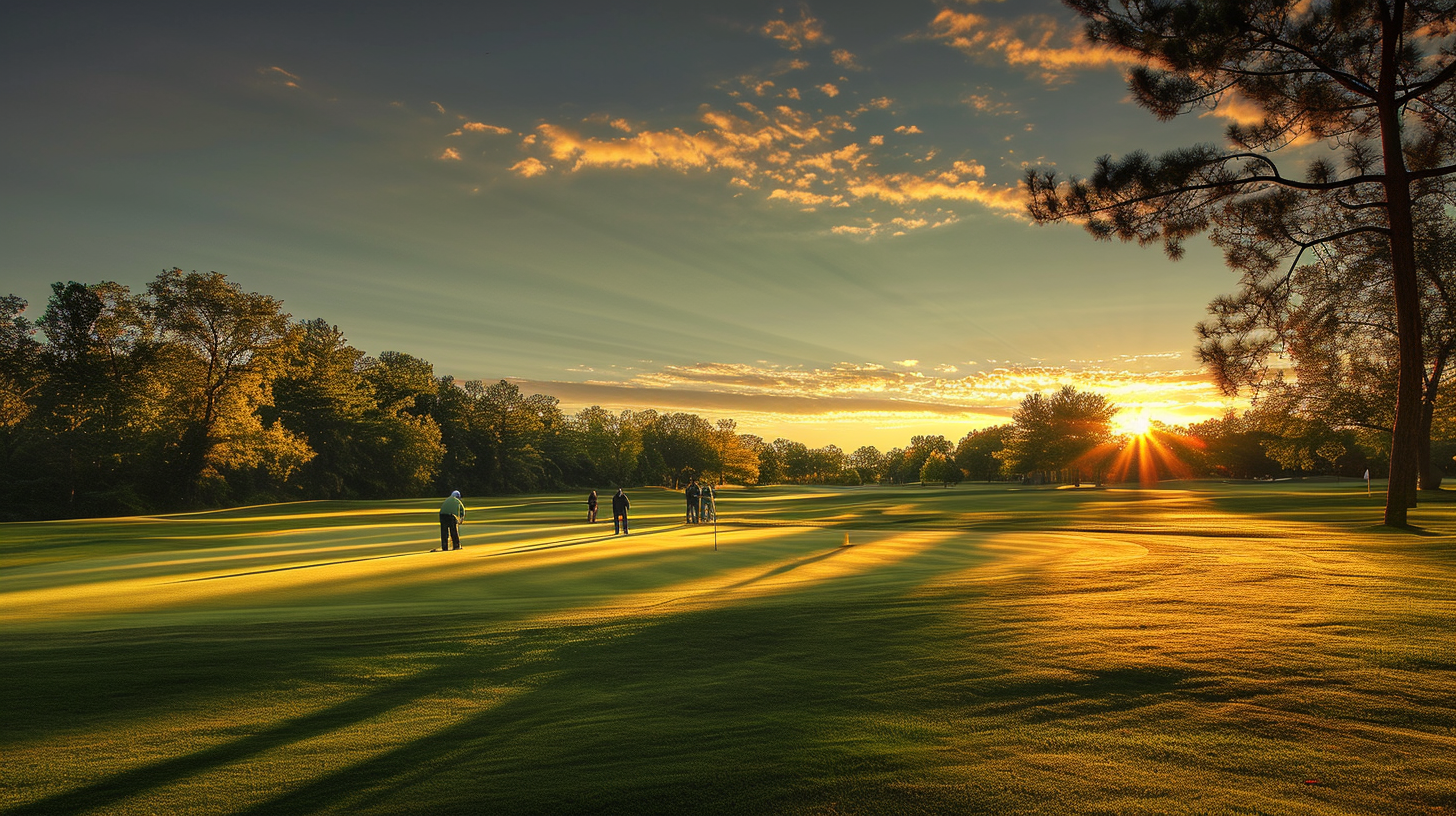Do you ever worry that your regular weekend golf round with buddies is taking too long when you play just 9 holes? Do you feel pressure to speed up from groups backed up behind you on the course?
Completing 9 holes of golf typically takes between 2 to 2 and a quarter hours on average when all common delays groups encounter are factored in.
Let’s dive into the key elements that determine pace of play over 9 holes to better understand what controls this timeframe.
How Long Does 9 Holes Of Golf Take?

A reasonable estimate falls right around 2 hours to 2 hours and 15 minutes.
This estimate appropriately accommodates for any delays due to limited player skill influencing additional strokes.
Some time spent looking for wayward shots resulting in lost balls, and typical bottlenecks caused by increased traffic on courses from threesomes and foursomes playing through.
It also builds in buffer for slower play caused by many players walking courses and having to traverse yardage between shots without golf carts. And it encompasses extra time taken by newer players unfamiliar with golf etiquette related to playing through holes efficiently.
Finally, it covers delays from pin positions on greens requiring careful club selection and additional practice swings on approach shots.
In many ways, 2 hours serves as the perfect target for completing 9 holes. Groups just focused on enjoying casual rounds with friends allowing for conversation, drinking, and general relaxation on the course should expect rounds to span over 2 hours based on common delays.
Yet groups seeking quicker play through walking briskly between shots, playing ready golf, limiting practice swings, and gently reminding players lagging behind to catch up can still achieve paces closer to 1 hour 45 minutes.
Ultimately the total time depends primarily on the expectations and motivations of the group members themselves. Player groups wanting to complete 9 quick holes for an evening round after work or before dark should budget 2 hours in most cases.
This accounts for typical delays while still motivating sufficient pace of play. Groups explicitly focused on speed golf or working on consistent pacing as a team can likely wrap up sooner.
And groups prioritizing friendship and recreation over speed should assume 9 leisurely holes will require over 2 hours pending other factors like large tournaments slowing down overall course traffic flow.
But for most players, targeting 2 hours for 9 holes hits the sweet spot accommodating reality without excessively rushing and sacrificing the inherent enjoyment of golf.
Factors That Impact Pace Of Play For 9 Holes

There are several key factors that can impact the pace of play for a round of 9 holes of golf. The skill level of the players in a group can have a significant influence, with beginners tending to play slower than more experienced golfers.
The difficulty and layout of the golf course itself also plays a role, as tougher holes with more obstacles naturally take longer to play.
Additionally, the number of players in a group impacts pacing, with singles and twosomes generally moving faster than threesomes, and foursomes slower yet. The time each player takes between shots and the general pace at which they play affects speed as well.
Rushing through shots can accelerate play, while taking time to prepare and think slows things down. Even weather conditions can have an effect, as nice weather brings more players out, slowing overall play, while rain or extreme heat leads to fewer players and faster play.
Skill Level Of Players
The skill level of the players in a golf group can impact the pace of play for 9 holes. Beginner golfers who are newer to the game tend to play slower than more experienced golfers.
Beginners may require more strokes to get the ball onto the green or in the hole due to lack of technique, reducing accuracy and distance on drives and approach shots. They may need to take several shots just to get the ball out of tricky lies like sand traps or heavy rough.
Beginners also spend more time searching for lost golf balls after errant shots into woods or high grass.
Other factors leading beginners to slow down the pace include taking several practice swings before shots, needing to be coached by partners on club selection or how to play certain tricky holes.
Not having confidence on putting greens and taking more time to line up putts, and not being as familiar with general golf etiquette related to pace of play.
Experienced players with lower handicaps generally are able to play 9 holes faster, requiring fewer shots and therefore spending less time playing each hole. Their improved accuracy also reduces time looking for lost balls.
Their familiarity with the golf course may also quicken the pace between holes as they swiftly move on to the next tee.
Difficulty And Layout Of The Course
The inherent difficulty and design layout of a golf course can significantly impact how long it takes a group to play 9 holes.
On golf courses with longer yardages, tougher holes featuring doglegs, forced carries over hazards, and smaller target landing areas naturally take more time simply because players must hit longer shots more accurately to reach the greens in regulation.
Tougher holes also lead to higher scores with more penalty strokes, slowing down play. Additionally, hazards like ponds, creeks, and sand traps force players to pause to make more complex risk-reward decisions.
Natural obstacles and impediments also factor in, like heavy rough which inhibits distance off the tee or accuracy from the fairways to the greens causing players to require more strokes.
Alternatively, relatively open and flat courses without as many hazards allow players to complete 9 holes faster. The routing or sequence of holes impacts pace too.
For example, 9 holes which start and end further from the clubhouse require longer walks between holes and cart rides back to the clubhouse to slow down play versus a routing where holes steadily build back closer to the clubhouse.
Also, back-to-back tough holes can cause groups to stack up, whereas interspersing an easier par 3 in between par 4s helps spacing between groups.
Size Of Group/Number Of Players
The number of players in a golf group is one of the most significant factors affecting pace of play for 9 holes.
Singles generally can play the fastest, as they can execute each shot without needing to coordinate with partners, quickly move to their ball, and efficiently play on their own schedule. Twosomes also move quite quickly, as two players can also swiftly move between shots.
Players get held up more when waiting on additional players to hit as the group size increases. Threesomes begin to lengthen out the playing time, as each player must wait longer from the time they hit each shot until it becomes their turn to hit again.
Foursomes often take the longest of the standard groupings, as players now wait even longer between shots while all members of the group play.
The more individual schedules and playing styles to coordinate between teammates, the more players must work together to maintain pace. Larger groups like five or six players should expect rounds extending well over two and a half hours for 9 holes.
More time is required for players hitting shots plus additional time congesting tee boxes, fairways, and greens while each player putts or moves to their next shot.
Larger groups also tend to socialize more as they play, inherently slowing pace versus groups intensely focused on playing faster.
Time Between Shots And General Pace Of Play
The pace at which each player plays, in terms of time taken before shots and between holes, can significantly impact how long a complete 9 holes takes.
Players focused on maintaining quick pace of play develop habits to speed up their shots, while players less concerned with quicker play slow things down by taking more time setting up and hitting shots.
Quicker players rush their actual shots, running between strokes and limiting pre-shot routines instead of taking time to think thoroughly about club selection or shot strategy. They also tend to walk faster between holes rather than casually strolling the course.
Quicker players also limit practice swings before shots, address putts more rapidly when reaching greens, and move on to the next tee promptly after holing out rather than lingering on greens reviewing previous putts at length.
Players who take time to think through decisions, take more practice swings to groove mechanics and visualize shots, meticulously line up putts, and chat between shots naturally extend 9-hole rounds compared to those rushing from one stroke to the next.
Additionally, newer players tend to lose numerous balls from errant shots, stopping to look for these instead of playing on to maintain pace.
Quicker groups can complete 9 holes in as little as an hour and a half, while slower groups can stretch rounds out to two and a half hours or longer depending on the various delays encountered.
Weather Conditions
Weather conditions can also impact how long it takes groups to play 9 holes or a complete round. Ideal weather leads more players to book tee times, leading courses to schedule groups at shorter intervals.
More players on the course invariably leads to waiting longer on tee boxes to tee off after preceding groups andwaiting longer to hit approach shots due to farther backups on par 4s and par 5s.
Sunny days also encourage more leisurely play and socialization as the weather puts players at ease versus quickly moving on against precipitation or extreme cold.
Alternatively, days with heavier rain, precipitation ranging from strong wind to snow, high heat and humidity all generally discourage some players from venturing out on the course.
Reducing the total players spread throughout the course opens up more spacing for groups between holes, reducing waiting and allowing groups to play through open holes. This reduces natural bottlenecks from congested par 4s and par 5s as fewer groups cause fewer delays.
Extreme heat also motivates groups to move more swiftly between shots rather than lingering in direct sunlight exposure on tee boxes.
Days with “nice” weather ultimately attract more players and reduce pace compared to days featuring inclement weather when fewer total players translates to faster play and shorter 9 hole rounds.
Average Time For 9 Holes Based On Group Size

Examining data from both amateur and professional players provides benchmarks for average time required to complete 9 holes of golf based on the number of players in a group.
Again, singles and twosomes normally move the quickest around the course with fewer delays caused by coordinating with multiple players’ schedules. The average solo player walking the course can complete 9 holes right around 1 hour 30 minutes to 1 hour 45 minutes.
This accounts for practice swings, walking times between holes, and roughly 5 minutes maximum per shot for challenging holes.
Twosomes fall into a similar range pending strong golfers playing scratch golf, although most estimate about 2 hours for 9 holes walking with clubs. This includes leaving the tee box while partners are still putting as well as playing ready golf to maintain movement.
Threesomes begin extending rounds closer to 2 hours and 10 to 15 minutes on average. Solo players get held up with one extra player and two groups begin backing up play on tee boxes and approach shots into greens with more traffic congestion.
Foursomes, popular given golf’s standard team versus match play, push endurance further to around 2 hours and 15 minutes to 2 hours 30 minutes.
Again, experienced players tightly focused on pace of play can potentially trim these estimates slightly through skillful play and course management. However, 2 hours 15 minutes serves as a reasonable average.
Any larger groups should reasonably expect 9-hole rounds to require at least 2 hours 30 minutes, with most public courses setting 2 hours 45 minutes as the limit before requiring groups to skip holes if running behind schedule.
Therefore, singles and twosomes should focus on 1 hour 30 minutes to 2 hours for 9 holes; threesomes plan for 2 to 2 hours 15 minutes; foursomes 2 hours 15 minutes to 2 hours 30 minutes; and larger groups over 2 hours 30 minutes.
Tips For Speeding Up Your Pace Of Play

While golfers cannot control course conditions, hole layouts impacting difficulty level, or weather, players looking to reduce round times should focus on areas within their control. Using a golf cart whenever allowed significantly increases pace of play versus walking.
Carts allow rapid transit between shots for all members of a group rather than trailing players needing to walk. Carts also provide closer access to greens and the next tee boxes compared to where players might have walked from.
Riding carts enable the first player to putt out and move immediately to their next shot location instead of everyone gathering around greens. Carts also reduce fatigue over 9 holes, keeping energy and mental sharpness up.
Ensuring golf bags are properly packed to begin each hole expedites play too. Taking a few extra minutes preparing for the round keeps players from delaying later to search bags at tee boxes for needed clubs, golf balls etc.
Being ready to hit shots as soon as it’s your turn makes a big difference over waiting on players to check yards, pull clubs, fix ball marks, determine stance, etc. Limiting practice swings also maintains pace by cutting down on time taken before actual strokes.
Players should visualize shots and make swing thoughts while waiting instead of lengthy pre-shot routines before stepping up to hit.
Adopting ready golf etiquette speeds play as well, allowing players to hit when ready instead of rigidly taking shots based on who is farthest from the hole.
Being lenient about gimme putts eliminates additional putting strokes which slow down groups the most once finally reaching the green. Trying to limit time taken looking for lost balls keeps play moving too, with a popular guideline being no more than 5 minutes per player.
Lastly, playing at a good pace means moving efficiently between greens and tees, without extensive post mortem about previous holes while other players ready to tee off must wait. Making minor adjustments like these positively impact average pace of play.
Conclusion
Golf is meant to be an enjoyable activity for players of all skill levels. While keeping pace of play moving is important, it’s also critical not to let focus on a stopwatch ruin the inherent pleasures of the game.
Targeting about 2 hours for a standard 9-hole round appropriately balances necessary pace with the laidback rhythm that makes golf such a beloved sport worldwide.



